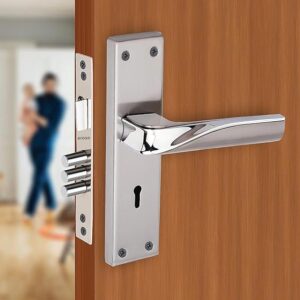As a lock manufacturer, delivering precision and reliability is paramount to ensuring customer security and satisfaction. In this article, we’ll explore critical aspects of lock manufacturing, focusing on advanced techniques, high-quality materials, and the technical factors that contribute to creating locks that meet both modern demands and traditional durability standards.
The Role of Material Selection in Lock Durability and Security
The first line of defense for any lock is its material composition. Selecting the right materials is essential not only for security but also for longevity and weather resistance. Common materials include:
- Brass: Known for its corrosion resistance, brass is often chosen for both interior and exterior locks. Its density and machinability make it ideal for creating intricate mechanisms.
- Stainless Steel: Particularly favored for high-security locks, stainless steel offers superior tensile strength, resistance to wear, and the ability to withstand extreme weather conditions.
- Hardened Steel: Used in padlocks and other high-security applications, hardened steel resists cutting and drilling, making it difficult for unauthorized access.
- Zinc Alloys: While lightweight, zinc alloys are strong and corrosion-resistant, making them suitable for applications where weight and rust resistance are concerns.
Each of these materials plays a unique role in determining the lock’s performance under various environmental and usage conditions. The specific choice depends on the lock type and security requirements, as well as factors like cost and end-user preferences.

Precision Manufacturing Techniques in Lock Production
Precision is non-negotiable in lock manufacturing, as even minor errors can compromise security. Some of the advanced techniques used in lock manufacturing include:
- CNC Machining: With CNC (Computer Numerical Control) technology, manufacturers achieve high levels of precision by programming detailed specifications into machines. This ensures that each component of the lock fits together seamlessly, reducing operational friction and wear over time.
- Laser Cutting: For high-security locks, laser cutting creates intricate and precise keyways that are resistant to picking and bumping. This method allows for unique, non-duplicable key designs.
- Automated Assembly: Advanced automation not only improves efficiency but also reduces human error, ensuring consistent quality across production batches. Robotic arms and AI-driven assembly lines are becoming commonplace in high-volume lock manufacturing.
- Heat Treatment and Hardening: In locks that require high resilience, components undergo heat treatment to increase hardness and durability. This step is critical for components like shackles and lock bodies, where strength is essential.
Advanced Security Mechanisms
Beyond the traditional pin-tumbler design, modern locks incorporate a variety of mechanisms to enhance security:
- Biometric and Electronic Integration: As more locks integrate with smart technology, biometric recognition (like fingerprint access) and electronic keypads add layers of security. This technology is especially useful in settings where key management is challenging, as it allows unique and trackable access codes.
- Anti-Pick and Anti-Bump Technologies: High-security locks often include specific designs to prevent lock-picking and bumping, such as spool pins, mushroom pins, and ball bearings that make it difficult for unauthorized persons to manipulate the internal components.
- Dual Locking Mechanisms: Some locks, particularly high-security safes, include dual locking mechanisms that require two distinct actions or keys to unlock. This design increases resistance to tampering and provides an additional security layer.
Quality Control in Lock Manufacturing
Quality control is a cornerstone in lock manufacturing to ensure every unit meets stringent security standards. Key quality control measures include:
- Tolerance Testing: Locks undergo testing to ensure they meet precise tolerances in dimensions and alignments. This is essential for ensuring smooth operation and resistance to forced entry.
- Lifecycle Testing: Many manufacturers perform lifecycle testing to simulate years of use. This involves repeatedly locking and unlocking each unit to check for mechanical integrity and durability.
- Corrosion and Environmental Testing: For locks intended for outdoor use, testing in salt spray chambers and other corrosive environments ensures the materials can withstand harsh conditions without degradation.
- Tamper Resistance Testing: Locks are tested against tampering techniques, such as picking, drilling, and bumping, to ensure they meet the required security levels.
Emerging Trends in Lock Manufacturing
As security needs evolve, lock manufacturers are responding with innovative solutions to meet emerging challenges. Some key trends include:
- Smart Lock Integration: With the rise of IoT (Internet of Things), smart locks are becoming more popular in both residential and commercial settings. Integration with smart home systems allows for remote access, tracking, and control, giving users real-time security management options.
- Sustainable Materials and Processes: Environmentally friendly materials and processes are increasingly sought after. Using recyclable materials, reducing waste, and minimizing energy consumption are priorities for manufacturers committed to sustainability.
- AI-Powered Design and Production: Artificial intelligence is being used to improve lock design, optimize manufacturing processes, and predict material performance. AI can simulate thousands of possible lock designs to enhance security features and streamline production.
Key Considerations for Customers When Choosing Locks

For customers selecting locks, understanding technical aspects can inform better choices. Here are factors customers should consider:
- Security Level: Locks should meet the appropriate security standards for the intended application. High-traffic areas or sensitive access points require high-security locks.
- Material Quality: Locks used in outdoor environments need materials resistant to rust and corrosion, like stainless steel or brass.
- Compatibility with Smart Systems: As more consumers adopt smart homes, compatibility with security systems, mobile applications, and voice-activated devices is an increasingly important factor.
- Manufacturer Reputation and Support: Customers should seek manufacturers known for quality, as well as post-purchase support options like warranties and technical assistance.
Conclusion
Lock manufacturing is a blend of precision engineering, advanced materials, and ever-evolving technology. By focusing on material quality, precision manufacturing, and quality control, lock manufacturers can create durable, secure products that meet diverse security needs. As customer expectations shift toward higher security and smart integration, manufacturers must adapt and innovate to remain competitive in a rapidly advancing industry.
In the end, high-quality lock manufacturing is about more than just physical security; it’s about ensuring peace of mind and adapting to the future of security technology.
